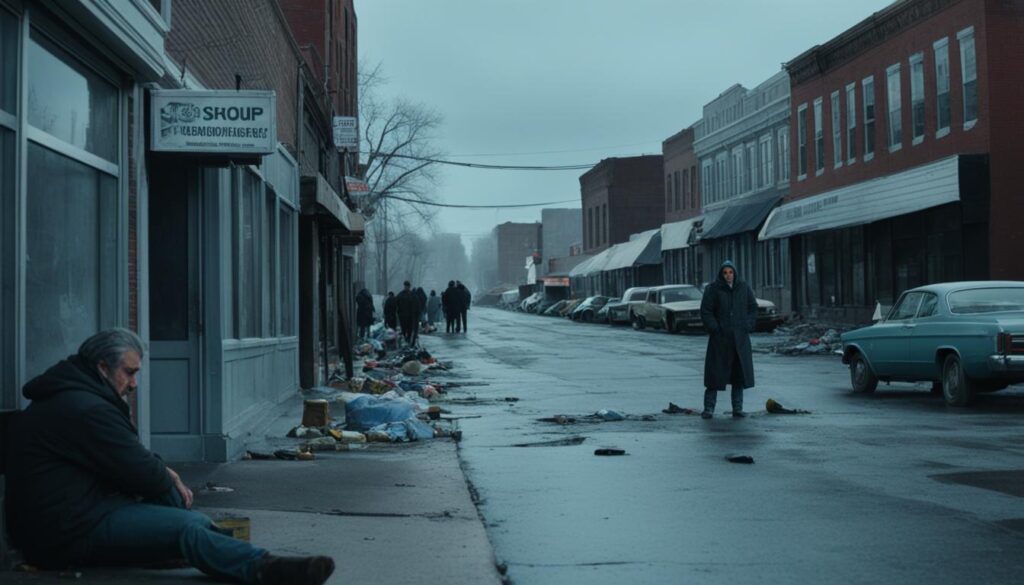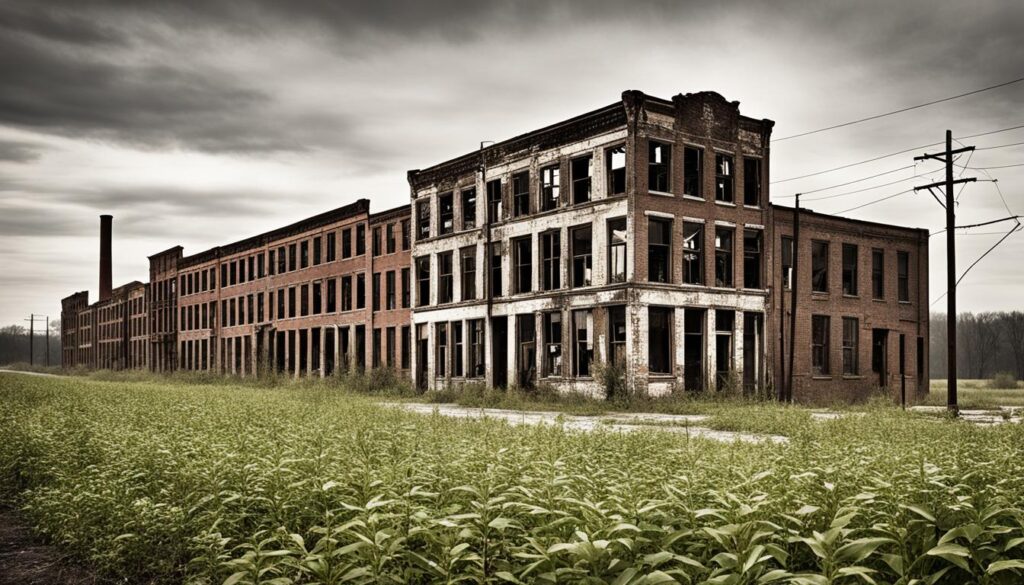“As an Amazon Associate I earn from qualifying purchases.”
Picture a time when society was falling apart. Dreams were crushed, and sadness filled every home. The Great Depression was a huge wave of economic collapse. It changed American life forever.
During this time, the country’s economic strength dropped by half between 1929 and 1933. Many banks failed, about one in five, causing chaos. In 1933, the jobless rate hit 25 percent. That meant 13 million people lost their jobs and struggled to survive.
The beginning of all this sadness was the stock market crash in 1929. It was a huge event that shook the finance world. Stock prices fell by 90 percent, causing deep wounds that lasted for more than 20 years. The impact of the Great Depression went beyond numbers, leaving lasting emotional scars.
Key Takeaways
- The Great Depression lasted over a decade, from 1929 to the early 1940s.
- GDP fell by 50 percent, and about 5,000 banks closed.
- In 1933, joblessness reached 25 percent, with 13 million people out of work.
- Stock prices dropped sharply in the 1929 crash, marking the start of the depression.
- President Roosevelt’s New Deal helped but didn’t bring a complete end to the hard times.
What Was the Great Depression?
The Great Depression hit the world, including the U.S., hard in the 1930s. It was not just a tough time. It was a long, hard period of severe economic decline. This downturn lasted over ten years.
Defining a Depression vs. a Recession
A recession is said to happen when the economy shrinks for two quarters in a row. On the other hand, a depression is a timespan with very low economic activity. This includes lots of people out of work, less stuff getting made, and very little money moving around.
Characteristics of the Great Depression
The Great Depression was a very long and deep economic crisis. It saw big drops in what the country made, how many people were hired, and how much money they made. It caused a lot of suffering. And that suffering came from problems like making too much, lending money too easily, and not enough people buying things.
Impact on the United States Economy
The impact of the Great Depression on the U.S. was horrible. GDP fell by half from 1929 to 1933. About 5,000 banks failed, wiping out people’s savings. Unemployment was very high, with 13 million losing jobs. This hit a quarter of all workers. The stock market lost 90% of its value. Recovery took over twenty years.
The duration of the Great Depression was especially tough. It led to fewer marriages and births. The baby boom after World War II helped make up for this. Still, the memory of that hard time stayed with those who went through it. They worried a lot about having to endure such tough times again.
The Great Depression Facts
The Great Depression shook the United States like never before, leaving deep scars. It changed how people lived and the events that followed shaped history.
Unemployment and Financial Turmoil
In 1933, a massive 24.9% of people were jobless. For Americans, this meant over 12 million were without work. Even those with jobs saw their pay drop by 42.5%.
This economic quake saw thousands of banks close. Many people lost their savings. The stock market crashed hard, dropping almost 90%.
President Roosevelt’s Response
President Franklin D. Roosevelt didn’t stand still. He introduced the New Deal, a set of projects to stabilize the economy. These projects gave jobs through groups like the CCC and FERA.
Lasting Effects on Society
The Depression’s impact went beyond money. It shaped how families formed and grew. It led to a ‘birth dearth’ that the 1940s baby boom later eased.
The Great Depression also left a fear of poverty in those who lived through it. This fear deeply influenced the way a whole generation thought and acted.
| Economic Indicator | Great Depression Impact |
|---|---|
| Unemployment Rate | Peaked at 24.9% in 1933 |
| Wage Income | Fell by 42.5% between 1929-1933 |
| Bank Failures | Around 5,000 banks failed |
| Stock Market | Stocks lost nearly 90% of value |
| Marriage Rates | Declined by 22% from 1929-1939 |
Parallels to the COVID-19 Crisis
The Great Depression and the COVID-19 pandemic were both “black swan” events. This means they were sudden, huge surprises. They quickly became too much for the usual systems to handle. In turn, these events led to massive suffering and lasting trauma.
They showed us how weak our systems were. The crises revealed problems in many areas of life. From health to the economy, we saw just how unprepared we were.
Unexpected and Overwhelming Events
The Great Depression and COVID-19 shockingly came out of nowhere. They grew quickly, causing overwhelming chaos. It was hard to deal with such large, unexpected problems. This made clear just how fragile our societies are.

Exposing Vulnerabilities in Institutions
The Great Depression uncovered weak spots in financial markets and the need for better regulations. These suggestions for change were also highlighted by COVID-19. It showed the world is too connected and not ready to act fast in a crisis.
| Economic Indicator | Great Depression | COVID-19 Recession |
|---|---|---|
| GDP Decline | 50% (1929-1933) | 5.0% (Q1 2020), 32.9% (Q2 2020) |
| Unemployment Rate | 25% (1933) | 14.7% (April 2020) |
| Stock Market Decline | 90% (1929-1932) | 20% (Feb-Mar 2020) |
| CPI Decline | 27% (Aug 1929 – Mar 1933) | Data not provided |
| Industrial Production | Data not provided | Plummeted initially, later recovered |
The table shows the severe economic consequences of both events. They had big impacts on the economy, jobs, and more. The Depression lasted longer but was less sharp. The COVID-19 recession was more sudden but didn’t last as long.
The Precarious Life Before the Depression
The Great Depression hit Georgia hard. Problems began in farming long before the crash in 1929. Overproduction, foreign competition, and man-made fabrics led to falling cotton prices. This hurt Georgia’s economy deeply since cotton was its main product.
Declining Cotton Prices and Agricultural Woes
In 1918, cotton prices were at their highest, reaching 28.88 cents per pound. But by 1931, they had sunk to just 5.66 cents. This huge drop was due to the dust bowl’s effects and the boll weevil pest.
Hardships for Sharecroppers and Farmers
About two-thirds of Georgia’s farmland was worked by poor sharecroppers in 1930. They made less than $200 each year. Bad farming practices and deforestation worsened the land. This caused many farmers to lose their land.
Things got worse due to a drought starting in 1925. Families struggling to farm faced even harder times. The problems from the Great Depression started before the stock market crash. This made life tough for Georgia’s farmers and rural folks.
The Stock Market Crash of 1929
The stock market crash of 1929 was a turning point. It triggered the Great Depression, a massive economic crisis. The 1920s saw a lot of borrowed money in the market. This led to a rush in stock prices. The Dow Jones Average jumped from 63 in 1921 to 381 in 1929.
But, this good time didn’t last long. The Federal Reserve knew trouble was coming. So, they raised New York’s discount rate to 6 percent. This made many other countries do the same, leading to a global crisis. Then, on October 28, 1929, the market crashed. The Dow lost nearly 13% on “Black Monday” and another 12% the next day.
By mid-November, the Dow had lost almost half of its value, a harbinger of the devastation that would ensue.
- The Dow dropped to 41.22 in 1932, the lowest of the century, down 89% from its peak.
- The crash hit industries hard. People stopped buying big items like cars.
- Companies like Ford had to cut back. They laid off workers as people stopped buying their cars.
Surprisingly, the damage wasn’t obvious at first. By 1930, people thought things would get better soon. But, the Great Depression hit hard. It changed America for years to come.
The Great Depression’s Impact on Georgia
The Great Depression’s economic crisis hit Georgia hard. It led to many bank failures and small businesses struggling. Due to a lack of credit and loans, money stopped moving. This made it hard for businesses of all sizes to keep going. Only big landowners and farmers using new crops survived at first.
Bank Failures and Small Business Struggles
Georgia, like the whole country, saw lots of banks fail. This hurt small businesses a lot because they couldn’t get loans. As the Great Depression spread through Georgia, these businesses couldn’t find the money to keep running or pay their workers.
Rural Poverty and Lack of Resources
Most people in Georgia lived in the rural areas back in 1930, about 69%. For them, the Great Depression brought a lot of poverty. Many didn’t have the basic needs like electricity or clean water. Diseases like pellagra, TB, and malaria were common, and there was little to no healthcare. The drought in 1930-31 made everything worse, especially for the farmers.

In Georgia, the price of cotton dropped greatly from 1918 to 1931. This devastated the farming community. Before the Great Depression, sharecroppers worked most of the land. But when the crisis hit, they lost nearly everything.
The Plight of African Americans
The Great Depression hit African Americans hard. It made life worse for them, with more discrimination and tough times. Many lost their jobs, and families moved to find work, starting the Great Migration again.
Racial Discrimination and Inequality
Before the Depression, Jim Crow laws and racism kept Black Georgians down. In 1930, there were few Black people in powerful jobs. For example, only a few Black-owned businesses existed. Jobs were few, with teaching being one of the main fields for African Americans.
The Great Migration Northward
Due to violence, low pay, and few chances in the South, African Americans kept moving to the North. This migration slowed during the Great Depression years. Because of this, Georgia’s Black population dropped from 47% to just 35%.
In 1932, around half of African Americans couldn’t find work. This was twice as high as the national average. In places like Atlanta, nearly 70% of Black workers didn’t have jobs in 1934. Historian Cheryl Lynn Greenberg highlights this staggering fact.
Cities like Chicago and Pittsburgh saw African American unemployment rates of over 50%. In Philadelphia and Detroit, this number reached as high as 60%. Seen from 1940, 1.75 million African Americans had moved to better their lives in the North and West.
Even with high unemployment, African Americans worked together for change in the 1930s. In the 1936 election, over 70% supported Franklin D. Roosevelt. He made many jobs for them in the government.
But, some New Deal programs were still against African Americans. For example, they faced segregation in camps and couldn’t get house loans in certain areas. These actions were by the Federal Housing Administration.
Roosevelt’s New Deal Policies
During the Great Depression, Americans looked to a leader for hope. Franklin D. Roosevelt promised new policies to help the economy. His presidency introduced big changes to fight the hard times. These efforts aimed to lessen the economic crisis’s severe effects of great depression.
Economic Relief and Recovery Programs
1933 saw Roosevelt start the New Deal soon after taking office. He launched several “alphabet agencies” like the AAA, CCC, and TVA. These efforts were designed to help many areas, from farming and factory jobs to fixing banks. They gave jobs and money to help the U.S. get back on its feet.

Late Arrival and Limited Impact in Georgia
Georgia saw the New Deal’s effects later than other places, with less of an impact. When Roosevelt visited, he learned about Georgia’s tough times. His efforts helped set the stage for future progress. However, true recovery for Georgia came during World War II. The war brought large spending and jobs, pulling the state out of the Great Depression.
The New Deal didn’t completely end the Depression. However, by 1936, it did lower jobless rates significantly to 14%. It marked a new chapter of the government helping its people. Though challenges remained, these policies started important changes in how the U.S. government cared for its citizens.
The Recession Within the Depression
The U.S. economy was getting better from 1933-1937 after the Great Depression. But, from May 1937 until June 1938, there was a tough time. This period, often called the “recession within the depression,” was very hard for many people.
This downturn was the third-worst of the twentieth century. It showed the economy was not stable yet.
The 1937 Economic Contraction
The real GDP dropped by 10% during this tough time. Unemployment rose to 20%, and industrial production fell by 32%. These big drops meant more people were out of work and businesses were making less.
Causes and Contributing Factors
Many things led to this part of the Great Depression. The Federal Reserve made a move in 1936 to slow down spending. But this had a negative effect by making it hard for people to borrow money.
Also, the government tried to control gold coming into the country. This made it harder for the economy to grow.
There was another problem too. The government started collecting new taxes for Social Security. This tax made things even harder for the economy until it was changed.
| Economic Indicator | 1937 Recession Impact |
|---|---|
| Real GDP | Fell by 10% |
| Unemployment Rate | Spiked to 20% |
| Industrial Production | Declined by 32% |
The 1937 recession during the Great Depression was a tough time. It showed how careful we need to be with money and economic decisions to avoid making things worse. This is a lesson still important today.
Conclusion
The Great Depression was a major economic downturn that changed America. For more than ten years, the country faced huge job loss, poverty, and financial problems. These issues began with the 1929 stock market crash.
During this time, production dropped by 47%, and the country’s wealth by 30%. The highest unemployment rate reached more than 20%. This left millions without jobs, showing weaknesses in the U.S. economy.
President Roosevelt’s New Deal helped by creating 8.5 million jobs. But, real recovery only came with massive spending during World War 2. These events taught us the importance of government help in tough times.
The Great Depression highlighted the need for a better safety net and stronger rules. It warned about the dangers of too much speculation and not enough oversight. The reforms that followed aimed to prevent such widespread suffering in the future.
This challenging time in history taught lasting lessons. It showed us the risk of taking stability for granted. It also highlighted how important it is to be ready for unexpected hard times.
FAQ
What was the Great Depression?
What were the lasting effects of the Great Depression?
How did the Great Depression and COVID-19 pandemic compare?
What were the economic conditions in Georgia before the Great Depression?
What caused the stock market crash of 1929?
How did the Great Depression impact Georgia’s economy?
What was the plight of African Americans during the Great Depression?
How effective were Roosevelt’s New Deal policies?
What was the recession within the Great Depression?
“As an Amazon Associate I earn from qualifying purchases.”

